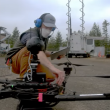Uplink considerations
Uplink receiver noise floor. For both LTE ENodeB or LMR base stations, the uplink (talkback) receiver is in a fixed environment for mobile data systems. Similar to the downlink case, the uplink receiver must distinguish between wanted and unwanted signals, so the thermal noise floor and effective receiver sensitivity must be estimated using Boltzmann’s constant. ENBW for LMR systems is the same for uplink and downlink, 6000 Hz. LTE can deliver additional resource blocks—in this case, 4 resource blocks—in the uplink to provide data speeds of 756 kb/s at the cell edge, and has an ENBW of 720 kHz. LMR systems use QPSK to deliver 12 kb/s throughout the area of the cell, also about 1 bit/second/hertz.
Assuming a noise figure of 2.5 dB for the LTE receiver, an ENodeB radio at the base-station sites, and a noise figure of 2.5 dB for the LMR receiver at the base-station sites, Boltzmann’s constant yields about -131 dBm for narrowband LMR channels and -127 dBm for the broadband channel. This again establishes the noise floor for both technologies in the uplink with a 4 dB advantage for LMR.
Uplink effective receiver sensitivity. The next step to calculate the effective receiver sensitivity of the uplink is to determine the minimum useable signal above the noise floor. With a minimal delivered data rate of 768 kb/s and using MS-4, LTE’s required SINR value is 0 dB plus a 11.5 dB Raleigh fast fade margin—or 11.5 dB. There is also a handoff gain of 2.8 dB and a fixed IoT gain of 3 dB for the LTE uplink.
For LMR systems with no tower-top amplifier or receiver multicoupler, a typical uplink value of faded C/(I+N), for a digital audio quality value of 3.4, is 17.7 dB. For LMR data transmissions of 12 kb/s, a typical faded C/(I+N) is 18 dB. The effective receive design value, or RSRP design threshold, for LTE broadband is -109 dBm, while the effective receiver design for LMR is -113 dBm—a 4 dB difference in favor of LMR systems.
Uplink transmission considerations. As with the downlink, the transmission to an LTE subscriber device with a 10 MHz bandwidth does not compare “apples to apples” with narrowband LMR transmissions of 12.5 kHz. At the subscriber device, LTE delivers data rates of 768 kb/s per user; for LMR systems, the bandwidth is 12 kb/s. Transmission power for LTE and LMR modem subscriber devices is 23 dBm, with a -4 dB antenna, for an ERP of 19 dBm.
Uplink antenna systems. LTE antenna systems utilize 12 dBd MIMO panel antennas and are sectorized, while LMR antennas are omnidirectional and have a gain of 9 dBd. LTE antenna systems in the uplink are 6 dB stronger than LMR systems, assuming the frequency bands are both 700 MHz and the transmission lines and filtering for LTE are 3 dB less than LMR. Uplink filtering losses and transmission lines are minimal for LTE when collocated with the transmitter, while the LMR transmission lines reach to the radio base station shelters and the losses are higher. Filter losses for LMR in the uplink are higher to allow for close narrowbanded channel separations.
Uplink maximum available path loss.To determine the uplink MAPL for LMR, start with a subscriber device transmitting 19 dBm ERP. Assuming the uplink LMR receiver is a radio base station with a 9 dB gain antenna, 2 dB transmission line losses and an effective receiver design level of -113 dBm, the MAPL is 139 dB. For LTE, the uplink MAPL is 19 dBm for the transmitter ERP and a base station ENodeB receiver antenna of 12 dBd, and an effective receiver design level of -109 dBm, with 6 dB for the fixed IoT and handoff factors—add it all up and the MAPL is 134 dBm. The difference is a 5 dB signal strength advantage for LMR.
Thus, the downlink MAPL for LTE is 127 dB and the downlink MAPL for LMR is 156 dB. The uplink MAPL for LTE is 134 dB and the uplink MAPL for LMR is 139 dB. So, the links for LTE are imbalanced by 7 dB downlink limited and for LMR are imbalanced by 15 dB uplink limited.
The next step is to attempt to balance these links. For LTE, with a downlink imbalance, one approach theoretically would be to increase the ENodeB transmitter power, but that would require 3GPP to develop better cell-edge interference mitigation techniques. With an LMR uplink imbalance, the best approach is to lower the base station transmitter power or add low-noise amplification before the base-station receiver.
The next article in the series applies these link-budget techniques to an RF planning tool to consider the uplink and downlink differences and the differences between predicted LTE and LMR coverage. With a downlink disadvantage of 29 dB, LTE coverage will be much less than LMR from the same site, even before the lower heights of LTE antennas are considered. With an uplink disadvantage of 5 dB, LTE coverage also will be less than LMR, but not as bad as in the downlink.
Robert C. Shapiro, P.E., is a consulting engineer who has been in land mobile radio engineering—including public-safety and transportation communications—since 1984. He serves on the TIA TR8 committee (TSB-88) as vice chair and is a senior member of the IEEE. He can be reached at [email protected].













